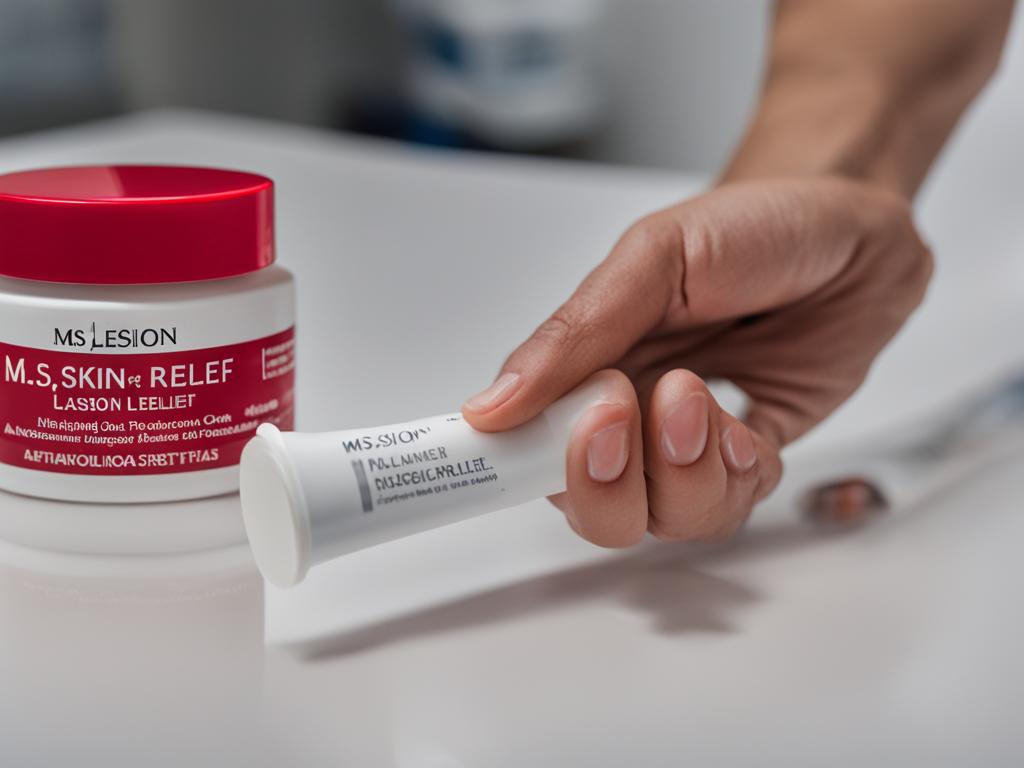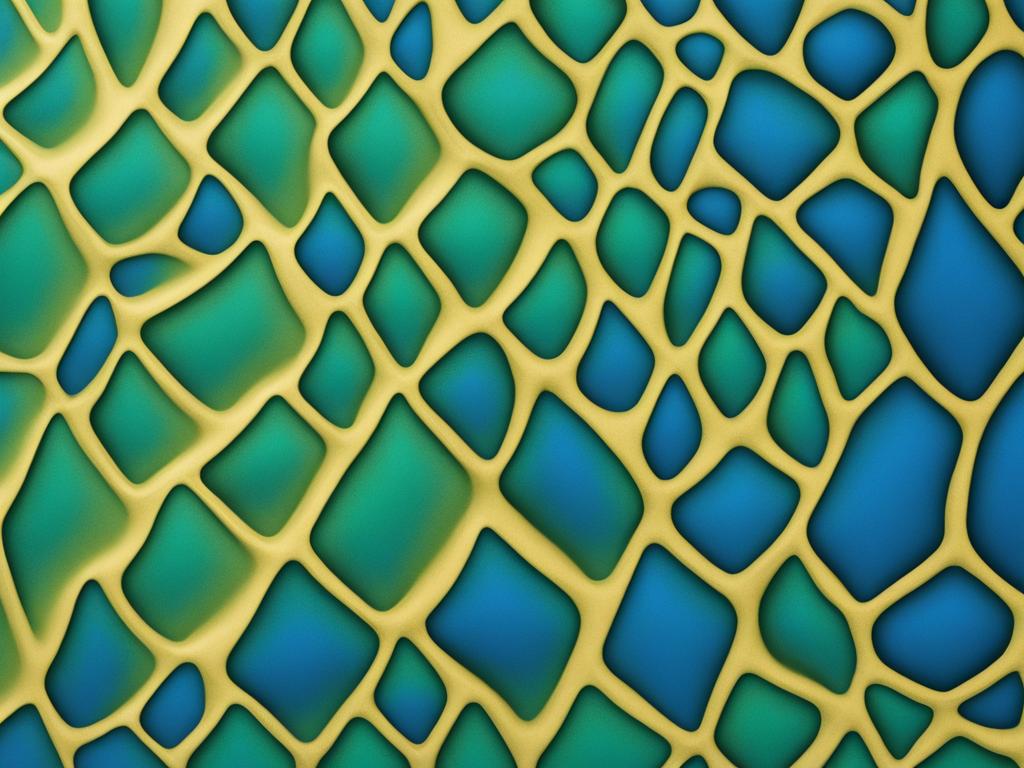Understanding Early Stage Multiple Sclerosis Skin Problem

Early stage multiple sclerosis skin problem : Multiple sclerosis (MS) is a chronic disease of the nervous system that can cause a range of symptoms. While MS itself does not directly cause skin lesions, it can lead to skin complications in early stages. These complications may include skin lesions, hives, and other dermatological symptoms. It is important to understand and manage these skin problems to improve the quality of life for individuals living with MS.
In this article, we will explore the causes, diagnosis, and treatment options for skin lesions in early stage multiple sclerosis. We will also discuss the various skin symptoms that can occur in MS and how to prevent and manage them effectively.
Key Takeaways:
- Multiple sclerosis does not directly cause skin lesions, but it can increase the risk of developing them in early stages.
- Skin lesions in MS are areas of skin that differ in appearance from the surrounding skin and can be symptomatic, such as hives, redness, itching, and thickened areas of skin.
- Causes of skin lesions in MS may include pruritus, side effects of oral medications, injection site reactions, and immune system suppression.
- Diagnosis of MS skin lesions involves examining the affected area, reviewing medical history, and ruling out other potential causes.
- Treatment options for MS skin lesions vary depending on the underlying cause and may include stopping medications, alternative medications, and specific treatments for hives and skin reactions.
Say, if you would like to know more about skin complications in early multiple sclerosis, read on!
What are MS Skin Lesions?
MS skin lesions are areas of skin that differ in appearance from the surrounding skin. These lesions are not caused by direct injury or conditions like psoriasis or eczema, but rather develop as a result of MS. Symptoms of MS skin lesions can include hives, red and swollen bumps, itching, and raised, thickened areas of skin. These lesions are often caused by excessive scratching or as a side effect of certain MS medications.
The appearance and severity of MS skin lesions can vary from person to person. Some individuals may only experience mild, temporary lesions, while others may have more persistent and pronounced lesions. The presence of skin lesions can also fluctuate over time, with periods of remission and flare-ups.
It is important to note that MS skin lesions are different from the lesions or plaques that develop in the brain and spinal cord in individuals with MS. These brain and spinal cord lesions are responsible for the neurological symptoms associated with the condition, while skin lesions primarily affect the appearance and sensation of the skin.
Symptoms of MS Skin Lesions:
- Hives
- Red and swollen bumps
- Itching
- Raised, thickened areas of skin
Causes of MS Skin Lesions:
- Excessive scratching
- Side effect of certain MS medications
“MS skin lesions are areas of skin that differ in appearance from the surrounding skin.”
Causes of Skin Lesions in MS
When it comes to the causes of skin lesions in multiple sclerosis (MS), several factors can contribute to their development. One common symptom experienced by people with MS is pruritus, or itchy skin, which can lead to skin lesions when excessive scratching occurs.
In addition to pruritus, certain oral medications used to treat MS may have side effects that can result in skin lesions. Medications such as cladribine, alemtuzumab, and natalizumab have been associated with the development of skin lesions in some individuals.
Furthermore, injection site reactions from self-injected MS medications can also cause skin lesions. These reactions can range from mild irritation to more severe symptoms, including the formation of lesions at the injection site.
| Possible Causes of Skin Lesions in MS |
|---|
| Pruritus (itchy skin) |
| Side effects of certain oral MS medications |
| Injection site reactions from self-injected MS medications |
Additionally, the immune system suppression caused by MS treatments can increase the risk of skin infections and related symptoms, which can ultimately lead to the development of skin lesions.
It is important for individuals with MS to be aware of these potential causes and work closely with their healthcare providers to manage and prevent skin lesions.
Diagnosis of MS Skin Lesions
When it comes to diagnosing MS skin lesions, healthcare providers employ a comprehensive approach to ensure an accurate assessment. The process typically involves examination of the affected area, review of the individual’s medical history, and consideration of other potential causes of the skin lesions. Through these steps, doctors can gather essential information that aids in making an informed diagnosis.
During the examination of the affected area, healthcare providers assess the appearance and characteristics of the skin lesions. They may observe the size, color, texture, and distribution of the lesions to determine if they align with typical MS skin lesions. Additionally, the presence of other accompanying symptoms, such as itching or inflammation, can provide valuable insights into the nature of the lesions.
Reviewing the individual’s medical history is another crucial aspect of the diagnostic process. Healthcare providers inquire about any previous diagnoses, treatments, or medications that may have contributed to the development of the skin lesions. This helps rule out other potential causes and establish a correlation between the lesions and the individual’s MS condition.
Moreover, healthcare providers consider other potential causes of skin lesions to ensure an accurate diagnosis. They may evaluate the possibility of injection site infections, other autoimmune diseases, severe scratching, or medication side effects. By ruling out these alternative causes, healthcare providers can confidently attribute the skin lesions to MS.
Overall, the diagnosis of MS skin lesions involves a meticulous examination, thorough medical history review, and consideration of other potential causes. This comprehensive approach enables healthcare providers to accurately diagnose and differentiate MS skin lesions from other dermatological conditions.
Treatment Options for MS Skin Lesions
When it comes to treating skin lesions in individuals with early stage multiple sclerosis (MS), various treatment options are available. The appropriate course of treatment will depend on the underlying cause of the skin lesions. One common approach is to stop the use of MS medications that may be causing the lesions and switch to alternative medications with a lower risk of skin complications.
In cases where the skin lesions are mild, healthcare providers may prescribe medications such as antihistamines and corticosteroids to help alleviate symptoms. Antihistamines can help reduce itching and hives, while corticosteroids can help reduce inflammation and promote healing. These medications can be administered orally or applied topically, depending on the severity of the skin lesions.
In certain instances, specific medications may be prescribed to target the underlying cause of the skin lesions. For individuals experiencing chronic hives as a result of MS, omalizumab may be used to help control these symptoms. Additionally, if there are signs of a skin reaction to MS medications, alternative treatment options may be explored to minimize the occurrence of skin lesions.
| Treatment Option | Description |
|---|---|
| Antihistamines | Medications that help reduce allergic reactions, including itching and hives. |
| Corticosteroids | Anti-inflammatory medications that can be administered orally or applied topically to reduce inflammation and promote healing. |
| Omalizumab | A medication used to treat chronic hives by targeting the immune response causing the symptoms. |
| Alternative medications | Exploring different MS treatment options to minimize the risk of skin lesions and related complications. |
It is important for individuals with MS to work closely with their healthcare providers to determine the most suitable treatment plan for their specific skin lesions. Regular monitoring and communication with healthcare professionals can help manage and improve the quality of life for those affected by MS skin complications.

Risk Factors for MS Skin Lesions
Developing skin lesions is a potential risk for individuals with early stage multiple sclerosis (MS). While there are no specific factors that make one person more likely than another to develop MS skin lesions, several considerations can contribute to their occurrence. It is important to understand these risk factors to better manage and prevent skin complications associated with MS.
Influence of Genetics
Genetic traits may play a role in increasing the risk of developing MS skin lesions. Research suggests that certain gene variations may contribute to the development of skin lesions in individuals with MS. However, the exact genetic factors that influence the risk are still not fully understood, and further studies are needed to determine the specific genes involved.
Effect of Immune System Suppression
The immune system suppression caused by MS treatments can increase the risk of developing skin infections and related symptoms. When the immune system is compromised, the body’s ability to fight off infections may be weakened, making individuals more susceptible to skin complications. It is essential for healthcare providers to carefully monitor and manage immune system suppression in individuals with MS to minimize the risk of skin lesions.
Impact of Treatment Medications
Some medications used to treat MS, such as oral medications and self-injected drugs, can have side effects that may lead to skin lesions. For example, certain oral medications like cladribine, alemtuzumab, and natalizumab have been associated with skin lesion development. Injection site reactions from self-injected MS medications can also cause skin lesions. It is crucial for individuals with MS to work closely with their healthcare providers to monitor and manage any medication-related skin complications.
| Risk Factors for MS Skin Lesions | Description |
|---|---|
| Influence of Genetics | Genetic traits may increase the risk of developing skin lesions in individuals with MS, though the specific genes involved are not fully understood. |
| Effect of Immune System Suppression | The immune system suppression caused by MS treatments can weaken the body’s ability to fight off infections, increasing the risk of skin complications. |
| Impact of Treatment Medications | Some medications used to treat MS, both oral and self-injected, can have side effects that may lead to the development of skin lesions. |
Understanding the risk factors associated with MS skin lesions can help individuals with the condition and their healthcare providers take proactive steps to prevent and manage skin complications. By closely monitoring immune system functioning, selecting appropriate treatment medications, and implementing preventive measures, the risk and impact of skin lesions can be minimized, improving the overall quality of life for those affected by early stage multiple sclerosis.
Outlook for People with MS Skin Lesions
For individuals with MS skin lesions, the outlook can vary depending on the severity of the condition and promptness of treatment. While MS skin lesions themselves do not impact the course of the disease, untreated lesions can lead to complications that affect the quality of life. Seeking timely medical attention and working closely with healthcare professionals is crucial for managing and improving the outlook for individuals with MS skin lesions.
Complications associated with untreated skin lesions can include infection, scarring, and discomfort. Skin infections can occur if the lesions are not properly cared for and kept clean. Additionally, continuous scratching or irritation of the lesions can lead to scarring, which may affect the appearance and texture of the skin. The discomfort caused by itching and pain can also impact daily activities and overall well-being.
By seeking prompt treatment and following healthcare professionals’ recommendations, individuals with MS skin lesions can effectively manage their condition and minimize complications. Treatment options may include stopping or adjusting medications that cause skin lesions, using alternative medications, and taking antihistamines or corticosteroids to alleviate symptoms. Regular check-ups and communication with healthcare providers play a crucial role in maintaining the best possible outlook for individuals with MS skin lesions.
In conclusion, while MS skin lesions can present challenges, proper management and treatment can help individuals with MS achieve a better quality of life. Prompt attention to skin lesions, adherence to medical advice, and open communication with healthcare professionals are essential for maintaining a positive outlook and minimizing complications associated with untreated lesions.

Understanding Skin Symptoms in MS
In addition to skin lesions, multiple sclerosis (MS) can manifest in a variety of skin symptoms. These symptoms are a result of the damage that MS causes to the brain and spinal cord, specifically affecting the sensory pathways. Individuals with MS may experience abnormal sensations on their skin, such as numbness, tingling, pain, itching, and the perception of unusual sensations like the feeling of insects crawling or water dripping on the skin.
These skin symptoms can be distressing and impact the quality of life for those with MS. It’s important for individuals living with MS to be aware of these potential symptoms and seek appropriate medical advice and treatment to manage them effectively.
Abnormal Sensations in MS
- Numbness: A loss of sensation or reduced sensitivity in different areas of the skin.
- Tingling: A sensation similar to pins and needles, often described as a “tingling” or “prickling” feeling.
- Pain: Skin pain in MS can vary from a mild ache to a sharp, stabbing sensation.
- Itching: Unexplained itching on the skin, sometimes accompanied by redness or rash-like symptoms.
- Abnormal Sensations: Some individuals with MS may experience unusual sensations, such as the feeling of insects crawling or water dripping on the skin.
The specific skin symptoms experienced may vary between individuals and can change over time. It is important to communicate any new or worsening symptoms to healthcare professionals for appropriate evaluation and management.

Managing Skin Pain in MS
Various treatments are available to help alleviate skin pain caused by MS. Antiseizure medications like carbamazepine, gabapentin, and pregabalin can help block the nerves’ ability to transmit painful sensations. Antidepressants such as nortriptyline, amitriptyline, and duloxetine can lower nerve excitability and provide relief. Topical treatments like lidocaine patches and capsaicin cream may be used to target specific areas of pain on the skin.
In addition to these medications, non-pharmacological approaches can also be helpful in managing skin pain. These may include acupuncture, mindfulness, meditation, and cognitive behavioral therapy (CBT). Engaging in low-impact physical activity, such as stretching or gentle exercises, can also help reduce overall pain levels and improve well-being.
It is important for individuals living with MS to work closely with healthcare providers to find the most suitable treatment approach and manage skin pain effectively. Regular communication, proper evaluation, and adjustment of treatment plans are vital to ensure the best possible outcomes for individuals with MS.
Types of Skin Pain Caused by MS
Skin pain is a common symptom experienced by individuals with multiple sclerosis (MS), and it can manifest in various forms. Understanding the different types of skin pain associated with MS can help individuals better manage their symptoms and seek appropriate treatment.
Paresthesias
One type of skin pain experienced in MS is known as paresthesias. Paresthesias are abnormal and temporary sensations that can include numbness, prickling, or a sensation of pins and needles. These sensations occur due to the disruption of nerve signals in the central nervous system caused by MS.
Hypoesthesia
Another form of skin pain associated with MS is hypoesthesia. Hypoesthesia refers to a loss of feeling or sensation in the skin. This can result in areas of the skin feeling numb or reduced sensitivity to touch or temperature changes.
Dysesthesias
Dysesthesias are painful sensations that individuals with MS may experience. These sensations can include burning, prickling, stabbing, ice-cold, itching, or electrical sensations on the skin. Dysesthesias are often described as abnormal and unpleasant sensations that can be triggered by even the slightest touch.
It is important for individuals with MS to communicate their specific skin pain symptoms to their healthcare providers to ensure appropriate diagnosis and management strategies are implemented.
| Type of Skin Pain | Description |
|---|---|
| Paresthesias | Abnormal and temporary sensations such as numbness, prickling, or pins and needles. |
| Hypoesthesia | Loss of feeling or sensation on the skin, resulting in numbness or reduced sensitivity. |
| Dysesthesias | Painful sensations like burning, prickling, stabbing, ice-cold, itching, or electrical sensations. |
Treatments for Skin Pain Caused by MS
Individuals with multiple sclerosis (MS) often experience various skin symptoms, including skin pain. The management of skin pain in MS typically involves a combination of medications and alternative therapies. These treatment options aim to alleviate discomfort and improve overall well-being.
Antiseizure medications are commonly prescribed to block the nerves’ ability to transmit painful sensations. Examples of antiseizure medications used for skin pain in MS include carbamazepine, gabapentin, and pregabalin. These medications help reduce nerve excitability and provide relief from skin pain.
Antidepressants can also be effective in managing skin pain caused by MS. Medications such as nortriptyline, amitriptyline, and duloxetine are commonly prescribed to lower nerve excitability and modulate pain signals. These antidepressants can help alleviate skin pain and improve quality of life.
| Medications for Skin Pain in MS | Examples |
|---|---|
| Antiseizure Medications | Carbamazepine, Gabapentin, Pregabalin |
| Antidepressants | Nortriptyline, Amitriptyline, Duloxetine |
In addition to medications, other treatment options for skin pain in MS include the use of lidocaine patches, topical creams like capsaicin cream, acupuncture, mindfulness, meditation, and cognitive behavioral therapy (CBT). These alternative therapies can help individuals manage their symptoms, reduce stress, and promote overall well-being.
It is important for individuals with MS to work closely with their healthcare providers to determine the most suitable treatment plan for their specific needs. Finding the right combination of medications and alternative therapies can help individuals effectively manage skin pain and improve their overall quality of life.
Prevention and Management of Skin Symptoms in MS

Managing skin symptoms is an important aspect of living with multiple sclerosis (MS). By implementing certain strategies, individuals with MS can help prevent and alleviate discomfort associated with skin issues. Here are some effective methods:
- Wear loose clothing: Opt for loose-fitting garments made from breathable fabrics to reduce friction and irritation on the skin.
- Massage therapy: Regular massage sessions can help improve circulation, relieve muscle tension, and promote relaxation, which may have a positive impact on skin symptoms.
- Hot or cold therapy: Applying heat or cold to affected areas can provide temporary relief from pain or itching. Warm compresses or ice packs can be used depending on individual preferences.
- Stress relief techniques: Stress can exacerbate skin symptoms. Engage in stress-relief activities like deep breathing exercises, meditation, or yoga to promote overall well-being.
- Low-impact physical activity: Engaging in gentle exercises like walking, swimming, or tai chi can help improve circulation, reduce stress, and promote overall skin health.
It is important to note that while these methods can help manage skin symptoms in MS, they may not completely eliminate them. It is always advisable to consult with healthcare professionals to determine the most appropriate management strategies for individual needs.
Conclusion
In conclusion, managing skin symptoms in MS is crucial for individuals with the condition. While MS itself does not directly cause skin problems, certain aspects of the disease or its treatment can lead to skin complications. It is essential for individuals with MS to work closely with their healthcare providers to diagnose, treat, and manage any skin symptoms they may experience.
By following proper care and monitoring, skin complications in early stage multiple sclerosis can be effectively managed, improving the quality of life for those affected. Treatment options, such as alternative medications with lower risk of skin lesions, antihistamines, and corticosteroids, can help alleviate symptoms and reduce the impact of skin problems on daily life.
Furthermore, prevention strategies like wearing loose clothing, engaging in stress-relief techniques, and incorporating low-impact physical activity can also contribute to managing skin symptoms in MS. By taking proactive steps and seeking timely medical attention, individuals with MS can effectively address skin complications, optimizing their overall well-being and enhancing their journey with the condition.
Also Read : 5 Steps To An Effective Evening Skin Care Routine For Glowing Skin
FAQs
Q: What are the early signs of multiple sclerosis (MS)?
A: Early signs of MS can include fatigue, numbness or tingling in various parts of the body, muscle weakness, and dizziness.
Q: What causes multiple sclerosis?
A: The exact cause of MS is unknown, but it is believed to involve a combination of genetic and environmental factors that lead to an autoimmune response targeting the myelin sheath of nerve fibers.
Q: What are the common symptoms of multiple sclerosis?
A: Common symptoms of MS include vision problems, muscle spasms, coordination and balance issues, bladder and bowel dysfunction, cognitive changes, and fatigue.
Q: When should I see a doctor regarding potential symptoms of MS?
A: If you experience any unexplained symptoms such as numbness, tingling, vision problems, or muscle weakness, it is important to see a doctor for evaluation and diagnosis.
Q: How is multiple sclerosis diagnosed?
A: A diagnosis of MS may involve a neurological exam, MRI scans, lumbar puncture (spinal tap), and evoked potential tests to assess electrical activity in the brain and spinal cord.
Q: What is relapsing-remitting multiple sclerosis (RRMS)?
A: RRMS is the most common form of MS, characterized by periods of new or worsening symptoms (relapses) followed by periods of recovery (remission).
Q: Is there a cure for multiple sclerosis?
A: Currently, there is no cure for MS, but there are disease-modifying therapies that can help manage symptoms, reduce relapse frequency, and slow disease progression.
Q: What are the early warning signs of MS relapse?
A: Early warning signs of an MS relapse may include increased fatigue, new weakness or numbness, vision clinically isolated syndrome problems, and difficulty with coordination.
Q: How does multiple sclerosis impact people who have the condition?
A: MS can affect individuals differently, leading to varying symptoms and degrees of disability, but with clinically doctor may prescribe isolated doctor may recommend ms symptoms symptoms may proper treatment and management, many people relapsing-remitting ms with MS lead active lives.
Q: What are the treatment options for people with multiple sclerosis?
A: Treatment for MS may include medication to manage symptoms and prevent relapses, physical therapy, occupational therapy, and lifestyle modifications to support overall well-being.





